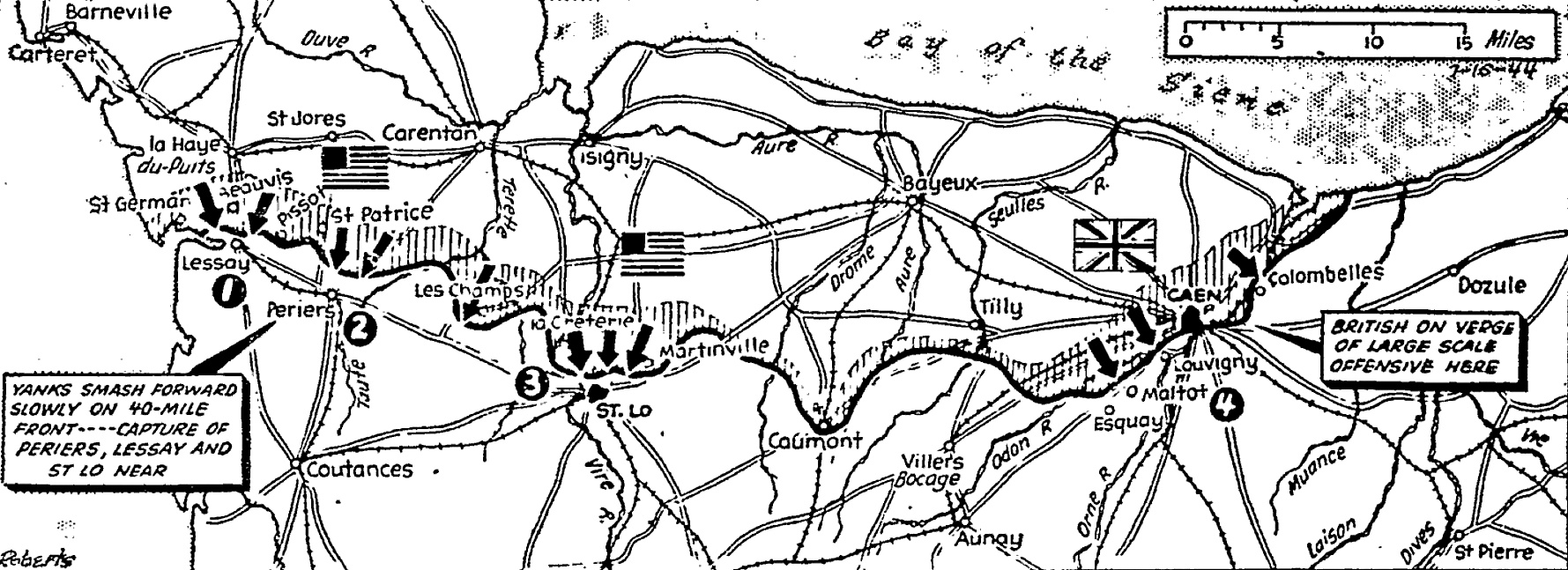
Roving Reporter
By Ernie Pyle
In Normandy, France – (by wireless)
The hospital was in our hands but just surely. On up the street a block there seemed to be fighting. I say seemed to be, because actually you can’t always tell. Street fighting is just as confusing as field fighting.
One side will bang away for a while, then the other side. Between these sallies there are long lulls, with only stray and isolated shots. Just an occasional soldier is sneaking about, and you don’t see anything of the enemy at all. You can’t tell half the time just what the situation us, and neither can the soldiers.
About a block beyond the hospital entrance, two American tanks were sitting in the middle of the street, one about 50 yards ahead of the other. I walked toward them. Our infantrymen were in doorways along the street.
I got within about 50 feet of our front tank when it let go its 75mm gun. The blast was terrific there in the narrow street. Glass came tinkling down from nearby windows, smoke puffed around the tank, and the empty street was shaking and trembling with the concussion.
As the tank continued to shoot, I ducked into a doorway, because I figured the Germans would shoot back. Inside the doorway there was a sort of street-level cellar, dirt-floored. Apparently there was a wine shop above, for the cellar was stacked with wire crates for holding wine bottles on their sides. There were lots of bottles, but they were all empty.
Crew comes boiling out of turret
I went back to the doorway and stood peeking out at the tank. It started backing up. Then suddenly a yellow flame pierced the bottom of the tank and there was a crash of such intensity that I automatically blinked my eyes. The tank, hardly 50 feet from where I was standing, had been hit by an enemy shell.
A second shot ripped the pavement at the side of the tank. There was smoke all around, but the tank didn’t catch fire. In a moment, the crew came boiling out of the turret.
Grim as it was, I almost had to laugh as they ran toward us. I never have seen men run so violently. They ran all over, with arms and heads going up and down and with marathon race grimaces. They plunged into my doorway.
I spent the next excited hour with them. we changed to another doorway and sat on boxes in the empty hallway. The floor and steps were thick with blood where a soldier had been treated within the hour.
What had happened to the tank was this: They had been firing away at a pillbox ahead when their 75 backfired, filling the tank with smoke and blinding them.
They decided to back up in order to get their bearings, but after backing a few yards the driver was so blinded that he stopped. Unfortunately, he stopped exactly at the foot of a side street. More unfortunately, there was another German pillbox up the side street/ all the Germans had to do was take east aim and let go at the sitting duck.
The first shot hit a tread, so the tank couldn’t move. That was when the boys got out. I don’t know why the Germans didn’t fire at them as they poured out.
The escaped tankers naturally were excited, but they were as jubilant as June-bugs and ready for more. They never had been in combat before the invasion of Normandy, yet in three weeks their tank had been shot up three times. Each time it was repaired and put back in action. And it can be repaired again this time. The name of their tank, appropriately, is Be Back Soon.
*Leave tank motor running
The main worry of these boys was the fact that they had left the engine running. We could hear it chugging away. It’s bad for a tank motor to idle very long. But now they were afraid to go back and turn the motor off, for the tank was still right in line with the hidden German gun.
Also, they had come out wearing their leather crash helmets. Their steel helmets were still inside the tank, so were their rifles.
“We’ll be a lot of good without helmets or rifles!” one of them said.
The crew consisted of Cpl. Martin Kennelly of Chicago (the tank commander), Sgt, L. Wortham of Leeds, Alabama (driver), Pvt. Ralph Ogren of Minneapolis (assistant driver), Cpl. Albin Stoops of Marshalltown, Delaware (gunner), and Pvt. Charles Rains of Kansas City (the loader).
Pvt. Rains was the oldest of the bunch, and the only married one. He used to work as a guard at the Sears-Roebuck plant in Kansas City.
“I was MP to 1,500 women,” he said with a grin, “and how I’d like to be back doing that!”
The other tankers all expressed loud approval of this sentiment.
